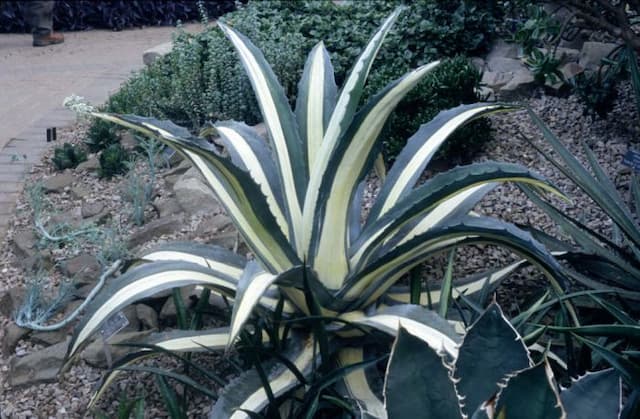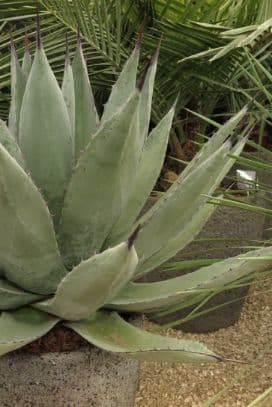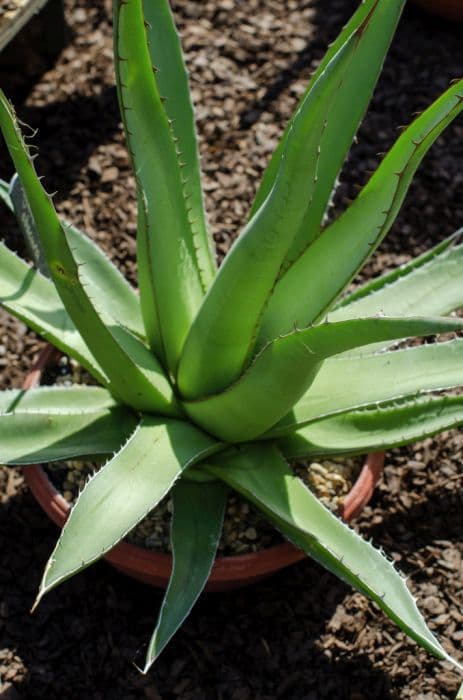Plantain Lily Hosta sieboldiana var. elegans

ABOUT
Hosta sieboldiana var. elegans, commonly known as Hosta 'Elegans', is an ornamental perennial with a lush and impressive appearance. This plant produces a dense clump of large, heart-shaped leaves that are known for their textured surface and a bluish-green color. The leaves are thick and have a notable seersucker-like pattern, with veins that are deeply impressed into the leaf surface giving it a puckered look. This variety of Hosta blooms in the early to midsummer, sending up tall flower stalks above the foliage that are adorned with bell-shaped flowers. These flowers are typically a soft, pale lavender to white color and hang down from the stems, attracting bees and other pollinators to the garden. The overall form of the 'Elegans' Hosta is that of a mound, with the leaves cascading down in a graceful fashion, creating a dramatic and eye-catching display in shaded garden areas. It is particularly well-suited for creating a lush ground cover or as a standout specimen in a border, and it thrives in those areas of the garden that are protected from the harsh afternoon sun.
About this plant
 Names
NamesFamily
Hostaceae
Synonyms
Plantain Lily, Funkia, Giboshi
Common names
Hosta sieboldiana 'Elegans', Hosta clausa var. normalis, Hosta sieboldii var. elegans
 Toxicity
ToxicityTo humans
The plant commonly known as Hosta is not considered highly toxic to humans. However, if ingested in large quantities, it may cause mild stomach upset, vomiting, or diarrhea. The symptoms are not usually severe, but if a large amount is eaten or if symptoms persist, it is best to consult a medical professional.
To pets
Hosta plants can be toxic to pets, particularly to cats and dogs. If a pet ingests any part of the plant, it may experience symptoms such as vomiting, diarrhea, and depression. In more severe cases, the ingestion could lead to more serious complications, but this is not common. If a pet shows symptoms of poisoning after consuming Hosta, it is advisable to seek veterinary care promptly.
 Characteristics
CharacteristicsLife cycle
Perennials
Foliage type
Deciduous
Color of leaves
Blue-green
Flower color
White
Height
2 feet (60 cm)
Spread
3 feet (90 cm)
Plant type
Herb
Hardiness zones
3
Native area
Japan
Benefits
 General Benefits
General Benefits- Low Maintenance: Hosta sieboldiana var. elegans, commonly known as Hosta, is renowned for its low maintenance requirements, making it a practical choice for both novice and experienced gardeners.
- Drought Tolerance: Once established, the Hosta plant exhibits a degree of drought tolerance, reducing the need for frequent watering.
- Shade Tolerance: Hosta thrives in shaded areas, making it ideal for garden spots that receive little direct sunlight.
- Ornamental Appeal: This Hosta variety offers attractive foliage with its large, blue-green leaves, providing visual interest in garden designs.
- Ground Cover: The plant's dense growth habit makes it an excellent ground cover, which can help prevent soil erosion and suppress weed growth.
- Long-Lived Perennial: As a perennial, it returns each year, contributing to a consistent and evolving garden landscape.
- Wildlife Attraction: The flowers of Hosta can attract pollinators such as bees, adding biodiversity to the garden.
 Medical Properties
Medical PropertiesThis plant is not used for medical purposes.
 Air-purifying Qualities
Air-purifying QualitiesThis plant is not specifically known for air purifying qualities.
 Other Uses
Other Uses- Leaf Impressions: Hosta leaves can be used to make leaf impressions in concrete for decorative stepping stones or garden path markers due to their large and textured foliage.
- Fiber Arts: The large leaves of the Hosta plant can serve as natural templates or stencils for quilting, embroidery, or other fiber arts.
- Garden Design: Hostas can provide a lush, textural contrast when used in shade garden designs alongside ferns and other shade-loving plants.
- Floral Arrangements: The flowers and foliage of Hosta plants can be incorporated into floral arrangements for a touch of greenery.
- Photography: Their broad leaves and elegant blooms make Hostas a popular subject for botanical photographers, particularly in the morning dew or after rainfall.
- Culinary Garnish: Though not commonly known for this use, the flowers of Hosta can be used as an edible garnish to add a unique touch to culinary presentations.
- Educational Tool: Hostas can be valuable in education settings to demonstrate plant growth, leaf anatomy, and shade garden ecology.
- Craft Projects: Leaves can be used in various craft projects, such as making leaf-shaped soaps or candles using Hosta leaf molds.
- Leaf Casting: Artists can use Hosta leaves in the process of leaf casting to create detailed concrete sculptures for garden ornaments or wall hangings.
- Water Garden Accent: Hostas can be planted around water features to create a naturalized look due to their tolerance for moist soil conditions.
Interesting Facts
 Feng Shui
Feng ShuiThe plant Hosta is not used in Feng Shui practice.
 Zodiac Sign Compitability
Zodiac Sign CompitabilityThe plant Hosta is not used in astrology practice.
 Plant Symbolism
Plant Symbolism- Devotion: Hosta sieboldiana var. elegans, commonly known as Hosta, symbolizes devotion due to its perennial nature, signifying enduring presence and loyalty.
- Heartiness: The Hosta plant is revered for its ability to thrive in shade and signifies resilience and adaptability in challenging conditions.
- Friendship: With its lush foliage that grows well alongside other plants, the Hosta represents camaraderie and the nurturing of relationships.
- Peace: The Hosta's broad leaves and gentle appearance impart a sense of tranquility, making it a symbol of calm and serenity.
 Water
WaterThe Hosta, commonly known as Plantain Lily, requires consistent moisture, especially during the growing season. The best method is to water deeply once a week, providing the equivalent of 1 inch of rainfall. This often translates to about 0.623 gallons for a square foot. During hot or dry spells, you may need to increase watering to twice a week. Avoid overhead watering to minimize the risk of leaf diseases, and instead aim to water at the base of the plant. Be cautious to not overwater, as Hostas do not like soggy soil.
 Light
LightPlantain Lilies thrive in part to full shade environments, making them a perfect choice for garden spots that don't receive direct sunlight. The ideal lighting condition would be dappled shade, like that under a canopy of deciduous trees. Avoiding exposure to harsh afternoon sun will help prevent the leaves from scorching.
 Temperature
TemperaturePlantain Lilies prefer moderate temperatures and can typically withstand minimum temperatures down to -40°F to -30°F in winter dormancy, and they will grow best in temperatures that do not often exceed 75°F to 85°F in the summer. They are cold-hardy and can survive in USDA Hardiness Zones 3 through 8, making them a versatile choice for various climates.
 Pruning
PruningPruning Plantain Lilies is mostly about removing dead or damaged foliage, and it is not crucial for growth. Trim old foliage in the spring before the new growth starts. Pruning can be done again in the fall to tidy up the plant and remove any spent flower stalks. This helps to maintain an attractive appearance and may prevent disease.
 Cleaning
CleaningAs needed
 Soil
SoilThe best soil mix for Hosta, commonly known as Plantain Lily, should be rich, moisture-retentive, and well-draining with a pH range of 6.0 to 7.5. A mixture of garden soil, compost, and perlite or coarse sand is ideal to ensure proper drainage and fertility.
 Repotting
RepottingHostas, including the Plantain Lily, should be repotted every three to five years. They benefit from being divided during this time, as it rejuvenates their growth and helps to manage their size.
 Humidity & Misting
Humidity & MistingThe Plantain Lily prefers moderately high humidity but is quite adaptable to the average outdoor humidity levels. It does not usually require additional humidity when grown outdoors in its preferred environment.
 Suitable locations
Suitable locationsIndoor
Ensure bright, indirect light and keep soil consistently moist.
Outdoor
Plant in shade to partial sun; keep soil moist but well-drained.
Hardiness zone
3-8 USDA.
 Life cycle
Life cycleHosta sieboldiana var. elegans, commonly known as Elegans Hosta, begins its life cycle as a dormant rhizome or a seed. Upon germination, it grows into a small seedling with just a few leaves. As it matures throughout the growing season, it develops into a clump-forming perennial, with a rosette of large, blue-green leaves that are heavily textured. During late spring to early summer, it produces tall scapes that bear funnel-shaped, lavender or white flowers, which are attractive to bees and other pollinators. After blooming, seed capsules form and once ripened, can disperse to produce new plants, although Elegans Hosta often reproduces vegetatively through its rhizomes. The plant enters a period of dormancy in the fall, with foliage dying back after the first frost, and the cycle begins anew in the spring.
 Propogation
PropogationPropogation time
Early spring
The Hosta, commonly known as Plantain Lily, particularly the Hosta sieboldiana var. elegans, is generally propagated through division. The best time to propagate Hosta plants by division is either in the early spring when the shoots are just emerging, or in the late summer after the plant has finished flowering. The popular method of division involves carefully digging up the established plant and using a sharp, clean knife or spade to split the root clump into smaller sections, ensuring that each section has at least two or three shoots or "eyes." These sections can then be replanted in prepared soil, ideally enriched with organic matter, and watered thoroughly to settle the roots into their new location. Each division should be spaced about 18 to 30 inches (45 to 76 centimeters) apart to allow enough room for growth. With proper care, the divisions will soon establish themselves and proliferate, providing new Hosta plants that are genetic clones of the parent specimen.









